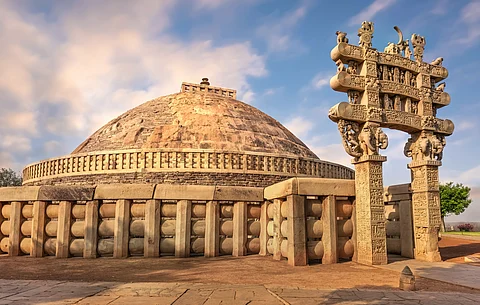
- Destinations
- Experiences
- Stay
- What's new
- Celebrating People
- Responsible Tourism
- CampaignsCampaigns
- SubscribeSubscribe
- Buy Now

The Ashokan Edicts are inscriptions created by Emperor Ashoka of the Mauryan Empire, strategically located along major trade routes and frontier areas. These edicts provide valuable insights into his governance, moral teachings (dhamma), and the extent of the empire. Carved over 2,200 years ago, the Ashokan Edicts convey timeless messages about Dharma, governance, and peace.
They are now included in UNESCO’s Tentative Heritage List (read more about it here) and mark significant locations along the ancient Mauryan route.
According to the UNESCO list, the edicts were placed on the outskirts of towns and along caravan routes, making them easily accessible to travellers and itinerant individuals. Today, remnants of the messages that Ashoka initially dispatched to his provinces can still be found at many of the original locations, as they were engraved on immovable rocks and boulders. One can explore their legacy and witness history engraved in stone on a trail following the edicts.
These inscriptions were carved into various surfaces. Some can be found on relatively flat, horizontal rock faces. Others are engraved on vertical surfaces. The accessibility of these rocks varies; for example, the Bairat edict in the Jaipur district of Rajasthan is located at the base of a hillside, while the Yerragudi edict in Andhra Pradesh is situated on steep, somewhat inaccessible ridges.
Ashokan edicts, which reflect Mauryan Emperor Ashoka's policies and dhamma, are located along Mauryan routes at sites such as Dhauli, Girnar, Yerragudi, Sanchi, and Lauriya Nandangarh, advocating for peace and non-violence. Here’s a look at some key sites and their significance:
Odisha, formerly known as Kalinga, is significant for being the place where Emperor Ashoka of Magadh experienced a profound transformation. After witnessing the brutality of war, he renounced violence and converted to Buddhism, actively promoting its spread across the region.
Dhauli, located near Bhubaneswar, is where this transformation took place, particularly after he saw the river Daya turn red with the blood of fallen soldiers. Dhauli is renowned for its rock edicts inscribed by Ashoka, which advocate for peace and non-violence.
When people think of Buddhism in the Indian subcontinent, Gujarat is not usually the first region that comes to mind. The 14 Ashokan rock edicts situated at the foot of Mount Girnar in Gujarat's Junagadh district are among the earliest archaeological evidence of the region's connection to Buddhism.
These edicts, carved on a granite block, date back to the 3rd century BCE and are inscribed in Brahmi script. They promote moral principles and Buddhist teachings, addressing issues related to religion, politics, and morality, while also describing Ashoka's transformation following the Kalinga War.
Sanchi, located in Madhya Pradesh, is a significant Buddhist site famous for its stupas and pillars, including one that features an edict of Ashoka. The prominent Buddhist monument features an Ashokan pillar with inscriptions, including a Schism Edict, which discourages divisions within the Buddhist community.
As one of the best-preserved landmarks in India, Sanchi exemplifies the flourishing of the Buddhist faith from the 3rd century BCE to the 12th century AD. The central chamber of the Great Stupa houses the last relics of Siddhartha Gautama, surrounded by four intricately carved toranas, which are free-standing arched gateways.
The Lauriya Nandangarh pillar, located in the West Champaran district of Bihar, is an impressive sandstone structure that features inscriptions of Ashoka's first six Major Pillar Edicts. These inscriptions are written in Ashokan Prakrit using the Brahmi script and promote principles of non-violence, ethical living, and compassion. Standing over 32 ft (10 m) high, this single block of polished sandstone has a bell-shaped top and a circular abacus adorned with Brahmi geese that support a statue of a lion. The edicts emphasise a commitment to non-violence and ethical behavior.
The Yerragudi rock edicts, also known as the Jonnagiri or Erragudi edicts, are a series of inscriptions created by the Mauryan Emperor Ashoka. These inscriptions, which promote the welfare of wildlife and outline the principles of Dhamma, are located on rocky boulders near the border of Andhra Pradesh and Karnataka, in a rural and remote area of peninsular India.
